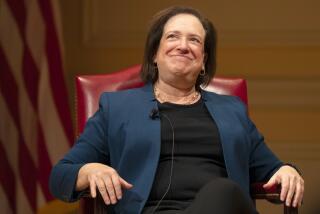A Shift in Style or an Ominous Warning?
- Share via
In judicial parlance a “precedent” is a prior ruling on a legal question by the same or a higher court--thus the ruling must be either followed or overruled.
Respect for precedent is one of the hallmarks of judicial restraint. “Activist” judges are frequently criticized by conservatives because they appear ready to overrule precedent based on their “personal predilections.” These judges respond that they cannot conscientiously join in applying a precedent that they believe was wrongly decided.
However, the comfort with which labels such as “activist” are affixed to judges was somewhat jarred recently by Justice Malcolm Lucas, a judicial “conservative” appointed to the California Supreme Court by Gov. George Deukmejian. In six prior death-penalty reviews Lucas had reluctantly agreed with decisions to reverse the sentence because a key precedent had not been followed in the lower court. That precedent requires instruction to the jury that it must find “intent to kill” before a sentence of death or life without parole can be imposed. In the case before the court on Nov. 18, Lucas did not agree with the majority in upholding that precedent. Is this merely a shift in style? Has Lucas suddenly become an “activist” seeking to overturn a precedent? Or is something ominous going on?
Whether a justice dissents or concurs may make little difference in the outcome of a case when he or she stands alone. But it can make a significant difference in the outcome of a retention election in which a justice’s voting record is reduced to a box score of results in death-penalty cases. Such box-score results reveal little about a justice’s reasoning. Former Chief Justice Donald Wright, for example, finished his career with a record of 172 reversals and 0 affirmances in death-penalty cases. Close examination of that record, however, reveals that all the reversals were compelled by two precedents, one of which was mandated by U.S. Supreme Court rulings.
Former California Chief Justice Roger Traynor expressed a preference that a jurist, having once registered dissent, follow the objected-to precedent in future cases. “He may thereafter properly note that he is concurring under compulsion, abiding the time when he may win over the majority, but he should regard dearly enough the stability of the law that governs all the courts in the state not to renew the rataplan of his dissent.” The dissent has a potential for mischief when a nucleus of dissenters on other issues becomes a majority by virtue of the vote of the unreformed dissenter. Traynor concluded, “Like many another judge, I have had to learn to give up dissenting while holding fast to a conviction.”
The countervailing view is represented by U.S. Supreme Court Justices William J. Brennan and Thurgood Marshall, who have dissented in every affirmance of a death penalty since 1976, adhering to their view that capital punishment is cruel and unusual despite the majority’s rejection of this view.
Obviously, a conscientious judge might choose either path. When the choice is a response to public criticism or political heat, however, there is grave cause for alarm. Judicial ethics require judges to decide cases “unswayed by partisan interests, public clamor or fear of criticism.”
Lucas was certainly aware that his concurring opinions, reluctant as they were, were still being recorded and reported as votes to reverse death-penalty judgments. The suggestion that a justice might switch his vote in such cases out of concern for the public perception of his “box score” is an ominous one. It lends credence to fears that the justices’ current reelection campaign may compromise the independence of the judiciary.
One of the ironies of judicial elections is that throwing out justices has no effect on the decisions that made them unpopular. The precedents remain in effect to be followed until they are changed by legislative enactment or constitutional amendment--unless, of course, they are “overruled” by the justices who are appointed as replacements. When a judicial house-cleaning is proposed as a means of overruling a precedent, however, the process can only be called “court-packing” in the truest sense of those words. A switch from concurrence to dissent is even more ominous if the implicit message to the electorate is “send me three more justices who agree with me and we’ll change the law.”
Lucas’ switch may be simply a change in style, although the new style puts him in the company of judges who are frequently labeled “activists.” In the context of current campaign rhetoric, however, the switch can be seen in more ominous terms. It may be an indication that the use of box-score results to measure the performance of justices actually affects how they decide cases. Or, even worse, it may be an invitation to change the law by changing the justices.
More to Read
Sign up for Essential California
The most important California stories and recommendations in your inbox every morning.
You may occasionally receive promotional content from the Los Angeles Times.













